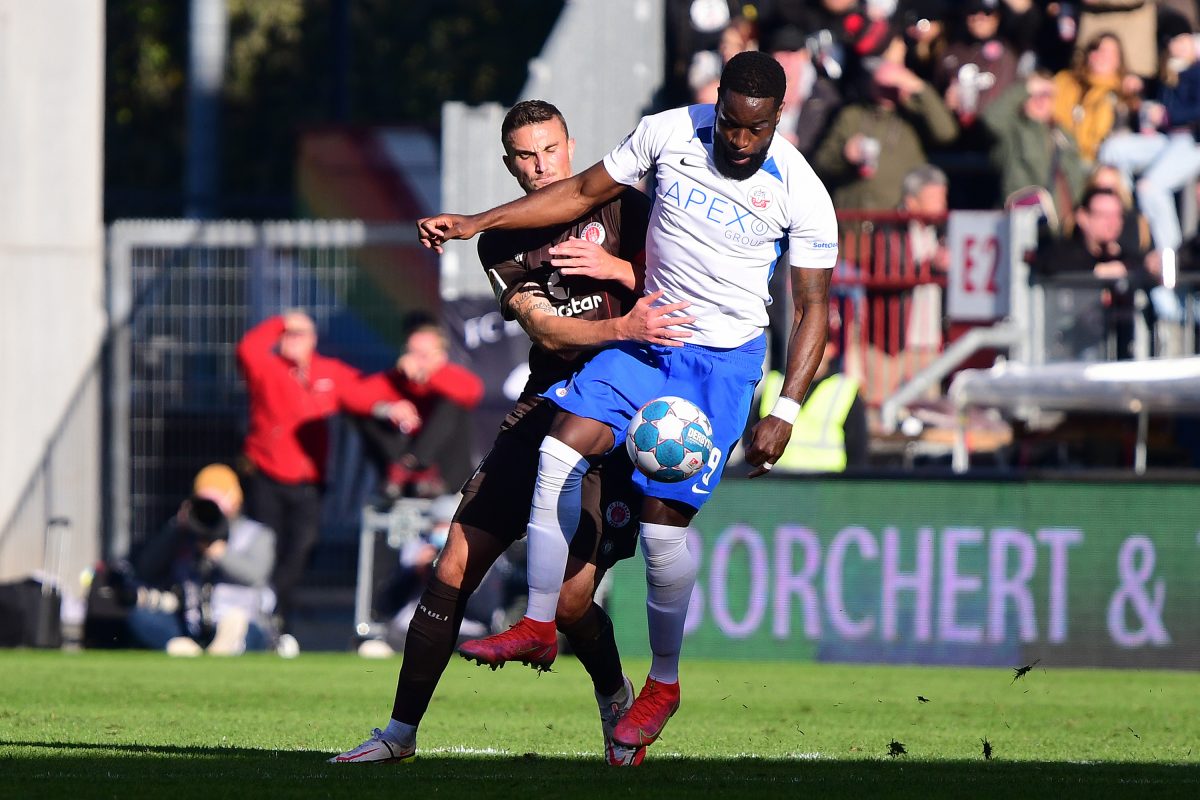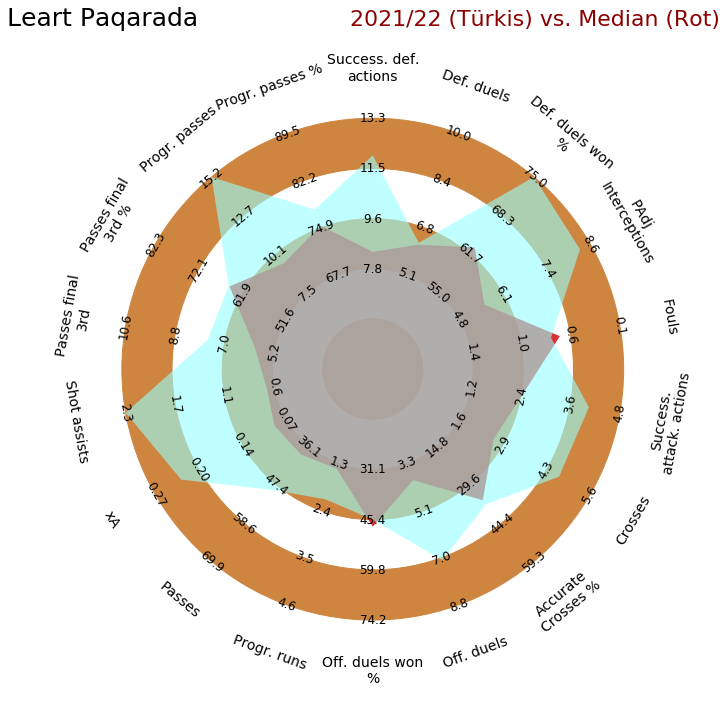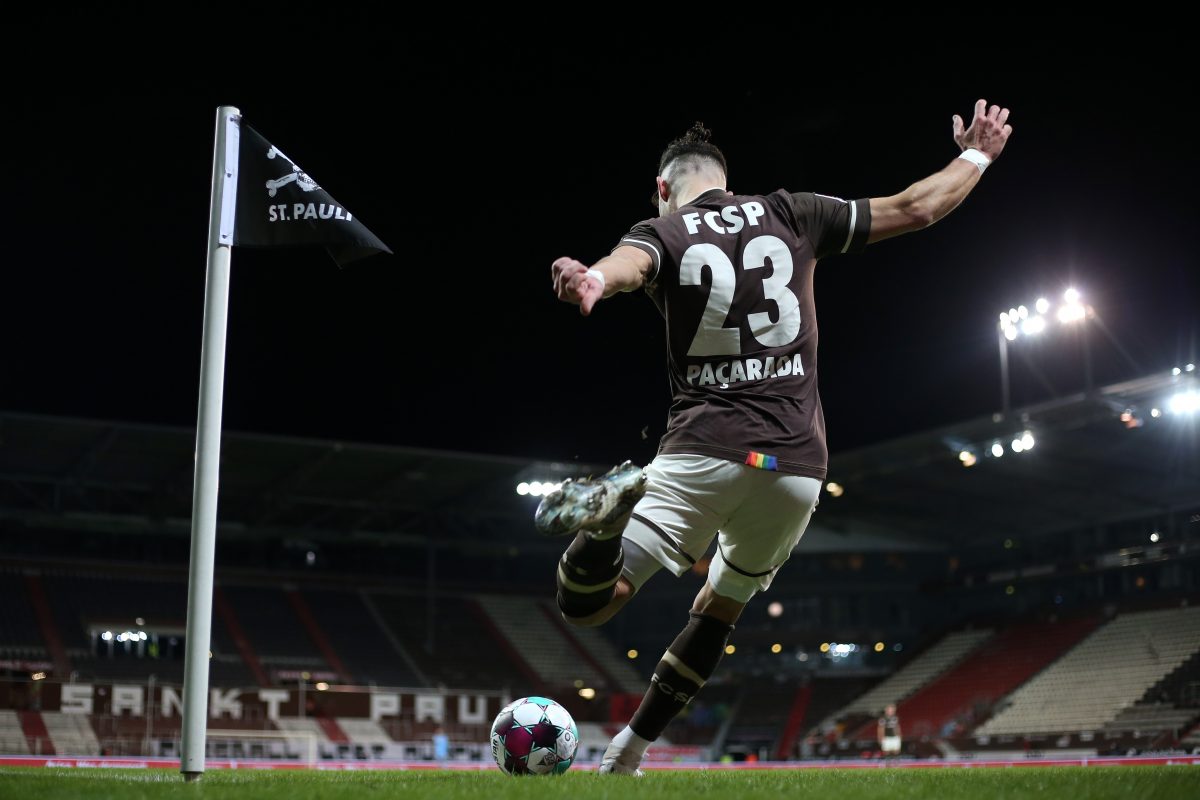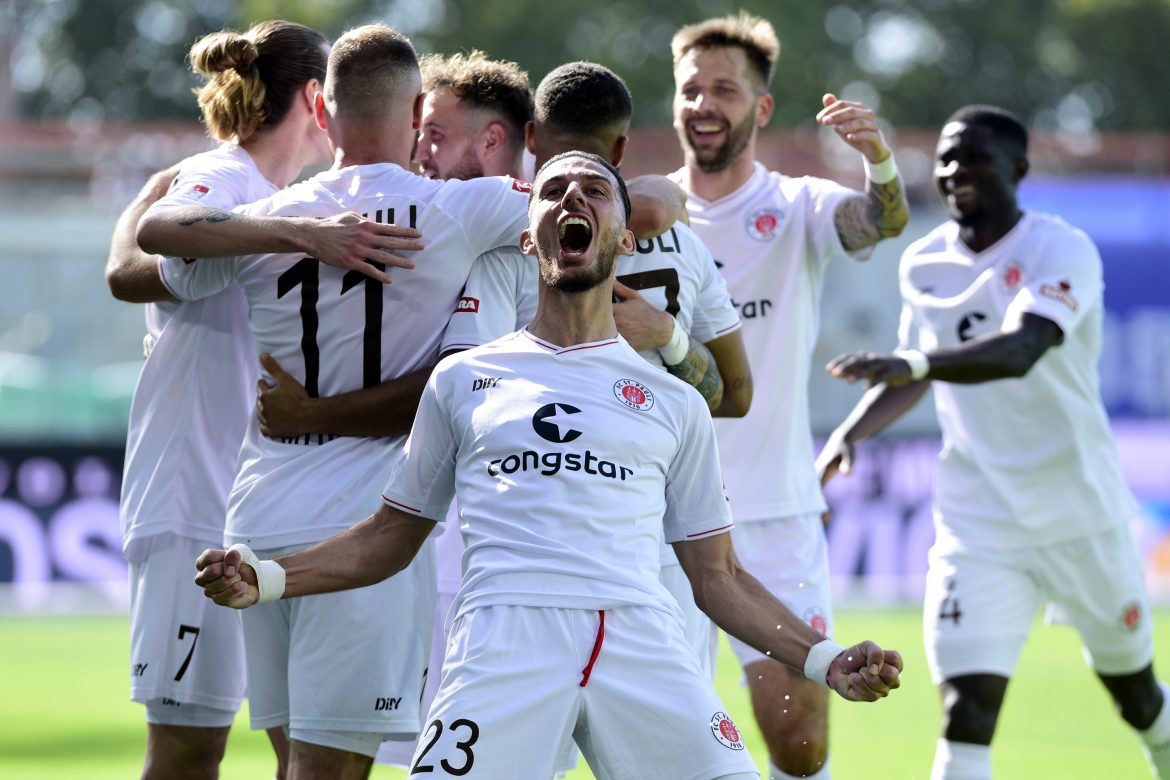25 Punkte nach 11 Spielen, Spitzenreiter – Der FC St. Pauli spielt eine bisher herausragende Saison. Wir schauen uns einmal die Zahlen und Statistiken an und versuchen herauszufinden, was den FCSP aktuell noch stärker als in der Vorsaison macht. Dabei wird deutlich, dass sich einiges verändert hat.
(Titelbild: Peter Böhmer)
Bekanntlich war ja bereits die Rückrunde der Vorsaison richtig gut. Nun scheint der FC St. Pauli aber irgendwie noch stabiler zu sein und zeigt auf dem Platz eine Dominanz, wie sie seit Jahren nicht zu sehen war. Und das nicht in einzelnen Spielen, sondern Woche für Woche. Aber an welchen Stellschrauben wurde gedreht, damit das nun so reibungslos läuft? Was macht der FC St. Pauli besser als noch in der Vorsaison? Es gibt mehrere Gründe bzw. Antworten auf diese Fragen.
Zweikämpfe
Es ist gar nicht so lange her, da präsentierten wir hier beim MillernTon wahrhaft erschreckende Zahlen. Im Januar 2021 fragten wir, ob es Sinn macht, noch einen Innenverteidiger zu verpflichten. Die Antwort fiel, basierend auf Statistiken, eindeutig aus: Die Innenverteidiger waren in den „Kernkompetenzen“ der Defensive wie Zweikämpfen und Kopfballduellen unterdurchschnittlich. Der FC St. Pauli verpflichtete damals mit Tore Reginiussen noch einen Spieler, aber bereits in der Rückrunde konnten sich auch Philipp Ziereis und James Lawrence stabilisieren.

(c) Peter Böhmer
Was jedoch in dieser Saison abläuft, ist schlicht eine unglaubliche Entwicklung. Der FC St. Pauli stellt aktuell mit knapp 66% gewonnener Defensiv-Duelle das zweikampfstärkste Team der gesamten Liga. Letzte Saison war das Team unterer Durchschnitt. Diese Veränderung kann gar nicht hoch genug eingeschätzt werden. Es sind tatsächlich nur rund sechs Prozentpunkte, um die der Wert gestiegen ist. Aber bei mehr als 60 Duellen pro Spiel macht das schon was aus. Zumal noch viel wichtiger ist, wo genau die neue Stärke Anwendung findet, also welche Spieler wie gut ihre Zweikämpfe führen.
Leart Paqarada ist der zweikampfstärkste Außenverteidiger der Liga mit 75% gewonnener Duelle. Zander liegt da auf Platz 7 mit 72%. In der Innenverteidigung liegen Philipp Ziereis (72%) und Jakov Medić (75%) in den Top15. Afeez Aremu liegt mit 73% gewonnener Duelle aktuell auf Platz 2 aller defensiven Mittelfeldspieler (Düsseldorfs Bodzek ist knapp besser). Bester Defensiv-Zweikämpfer auf der Zehnerposition ist, und das verwundert mich schon ein wenig, Daniel-Kofi Kyereh. Im zentralen Mittelfeld liegen Finn Ole Becker auf Platz 10 (63%) und Jackson Irvine auf Platz 12 (61%). Einzig Marcel Hartel fällt da etwas ab (Platz 26 mit 55%), aber der führt dafür das zentrale Mittelfeld bei den abgefangenen Pässen an. Nur ganz vorne im Angriff liegen die Stürmer recht abgeschlagen im unteren Ligaschnitt (was aber auch an der Pressingweise liegen dürfte, da ein verlorenes Duell zwar als verloren in die Statistik eingeht, aber der FCSP damit den Ball genau auf der Seite hat, wo sie ihn haben wollen).
Angesprochen auf diese Entwicklung verweist Timo Schultz ebenfalls darauf, dass es bereits in der vergangenen Rückrunde Verbesserungen in den Zweikämpfen gab. Er hebt dabei besonders, wer hätte es gedacht, Jakov Medić hervor. Aber auch bei Philipp Ziereis betont er, dass dieser sich enorm verbessert habe. Schultz betont auch, dass es nicht nur die individuelle Stärke der Spieler ist, die sich verbessert hat:
„Wir haben uns als Mannschaft verbessert im Defensivverhalten. Diese Zweikampfstatistiken leben auch extrem davon, wie ich als Mannschaft funktioniere. Wie kompakt stehe ich? Wie schnell kann ich in den Zweikämpfen sein? Wie gut ist das Gegenpressing?“
Timo Schultz
Der FC St. Pauli ist in Sachen Zweikämpfe einfach nicht wiederzuerkennen und deutlich das Maß der Dinge in der 2.Liga. Wer hätte das gedacht, nachdem es vor wenigen Monaten noch hieß, dass es dem Team komplett an Physis mangelte? Natürlich ist Jakov Medić ein enorm wichtiger Faktor. Aber Ziereis, Aremu, Paqarada – die waren alle schon da letzte Saison. Und sie haben sich in Sachen Zweikampfführung scheinbar weiterentwickelt. Das finde ich besonders bemerkenswert.
Wo wir gerade bei „Maß der Dinge“ sind. Wir hatten bereits vor einiger Zeit einen Artikel mit dem Titel „Der beste Linksverteidiger der Liga?“ veröffentlicht. Nun können, nein, müssen wir aus dem Fragezeichen ein Ausrufezeichen machen. Leart Paqarada ist schlicht der beste Außenverteidiger der Liga! Schaut mal hier:

Paqarada hat die beste Zweikampfquote aller Außenverteidiger. Zudem gibt niemand mehr Torschussvorlagen und spielt mehr progressive Pässe (= Pässe, mit denen ein Team dem gegnerischen Tor erheblich näher kommt). Nur Nürnbergs Tim Handwerker schlägt mehr Flanken. Und nur in zwei Kategorien (Anzahl an Fouls und Quote bei den Offensivduellen) ist Paqarada leicht schwächer als der Liga-Durchschnitt. Angesichts der weiteren Statistiken ist das absolut verkraftbar.
Fouls
Wo wir gerade bei Fouls sind: Erst 90x beging der FC St. Pauli während der ersten 11 Spiele ein Foul. Das sind knapp 7.7 Fouls pro Spiel. Der deutlich niedrigste Wert aller Zweitligisten. In der Vorsaison lag der FCSP mit 12.9 Fouls pro Spiel auf Platz 14.
Fouls sind natürlich auf der einen Seite teilweise unvermeidlich, da Zweikämpfe an der Schwelle zum Foul geführt werden. Aber wenn es schon regelwidrig sein muss, dann zumindest in recht ungefährlichen Situationen. Beim Blick in die detaillierte Foul-Statistik fällt auf, dass der FCSP besonders dort, wo der Gegner eine gute Freistoß-Position bekommen würde (in der zentralen Defensive) fast nie foult. Philipp Ziereis foult 0.47x pro Spiel, also jedes zweite Spiel einmal. James Lawrence ist noch fairer mit 0.3 Fouls pro Spiel. Das bedeutet Platz 7 und 5 in der Liga unter den Innenverteidigern. Der fairste Innenverteidiger der Liga? Jakov Medić begeht nur knapp jedes vierte Spiel ein Foul. Im defensiven Mittelfeld liegt Afeez Aremu mit knapp einem Foul pro Spiel auf Platz 6. Das sind überragende Werte für den FC St. Pauli.
Standards
Wo wenig Fouls sind, gibt es wenig Freistöße. Das ist ein Mitgrund, aber nicht alleinig der Grund für eine weitere Stärke, die früher eine große Schwäche war: Der FC St. Pauli hat sich in dieser Saison noch kein einziges Gegentor nach einem Standard gefangen. Das ist mehr als ungewohnt. Blog-Kollege Maik twittert nicht einfach so „Kein Gegentor nach Ecke„, nach jedem Spiel, in dem der FCSP keines gefangen hat. Vielmehr ist es ein Relikt aus vergangenen Tagen, als Gegentore nach Ecken so etwas wie eine Unvermeidlichkeit darstellten.
Das ist es nun schon länger nicht mehr. Die Stärke bei gegnerischen Standards ist auffällig. Entsprechend haben wir Timo Schultz auf der letzten Pressekonferenz danach gefragt. Er hob die individuelle Stärke der Spieler hervor und zeigte sich ebenfalls erfreut, wie stabil sein Team bei Standards ist. Das liege aber nicht nur an der Physis, sondern auch an der Einstellung. Seine Spieler haben die „Wichtigkeit dieser Situationen erkannt“ und sie würden sich entsprechend selbst pushen bei den Defensiv-Standards.
Offensiv zeigt sich ein anderes Bild: Der FC St. Pauli ist zwar keine Tormaschine nach Standard-Situationen, hat aber bereits drei zwei Treffer nach Ecken erzielt (der letzte durch Makienok gegen Rostock). Das finde ich schon fast zu wenig, wenn man sich anschaut, welche großen Chancen der FCSP teilweise v. a. nach Freistoß-Varianten hatte. Aber angesichts von 23 Toren aus dem laufenden Spiel in elf Matches ist das natürlich verkraftbar.

(Cathrin Mueller/Getty Images/via OneFootball)
Offensivfußball
Ja, richtig, 23 Tore aus dem laufenden Spiel. Das ist natürlich ein Bestwert in der Liga, so wie auch die bisher 27 erzielten Tore des FCSP Ligaspitze sind. Der Offensivfußball war bereits in der Vorsaison richtig gut und der FCSP ist immer fähig, vorne Chancen zu kreieren. In dieser Saison sind sie das Team, das sich die meisten Großchancen erspielt und den dritthöchsten xG-Wert der Liga aufweist. Grund hierfür ist der Kombinationsfußball, der uns alle aktuell Woche für Woche begeistert. Kein Team bringt häufiger Pässe im gegnerischen Strafraum zum Mitspieler. In den Kategorien der „wichtigen“ Pässe (Überspielen der gegnerischen Ketten, Torschussvorlagen, Pässe aus dem Druck heraus), liegt der FCSP jeweils in den Top3 der Liga. Bei der Anzahl der Torschüsse ist es aber „nur“ Platz 4, was direkt zum nächsten Punkt überleitet…
Effektivität
156 Torschüsse, also etwas mehr als 13 pro Spiel feuert der FC St. Pauli ab. Die daraus erzielten 27 Tore bedeuten, dass der FCSP weniger als sechs Torschüsse (5.8) für ein Tor benötigt. Nur Darmstadt 98 hat eine bessere „conversion rate“ mit 5.3 Torschüssen pro Tor.
Ein Wert von weniger als sechs Torschüssen pro Tor ist enorm effektiv. In den drei Saisons zuvor lag dieser Wert beim FC St. Pauli immer über acht. Das ist auch in etwa der durchschnittliche Wert aller Teams. Sollte es also sein, dass der FCSP hier überperformed und wir zukünftig weniger Tore erwarten müssen? Womöglich kann die Quote nicht ganz gehalten werden, ja. Aber der xG-Wert spricht eher dafür, dass der FC St. Pauli auch weiterhin weniger als die durchschnittlichen acht Schüsse pro Tor brauchen wird. Denn der FCSP hat den dritthöchsten xG-Wert pro Torschuss und dürfte bei dieser Zahl entsprechend auch weiterhin eine sehr gute „conversion rate“ haben. Außerdem gibt es ja GB9 in unseren Reihen…
Ja, die eigene Offensive ist berauschend und aktuell sehe ich keinen Gegner in der zweiten Liga, der da gegen uns alles wegverteidigen kann. Das war aber auch in der Vorsaison ähnlich, wenngleich nicht ganz so ausgeprägt. Stark verbessert hat sich der FC St. Pauli in Sachen Defensive. Besonders die Zweikampfstärke ist eine krasse Weiterentwicklung. Gleiches gilt auch für die Anzahl an Fouls, welche einhergeht mit wenig Standard-Gegentoren.
Ja, is mir auch klar, das wird bestimmt nicht die gesamte Saison so rosarot weitergehen. Auch wenn es uns momentan schwerfällt, das zu glauben, aber der FCSP wird auch noch Spiele verlieren, vermutlich auch noch ein-zwei Gegentore nach Ecken fangen. (Anm. Maik: Noooooo!) Doch aktuell habe ich das Gefühl, das schon richtig viel auf einmal schieflaufen muss, damit Spiele nicht gewonnen werden.
Die wohl wichtigste Statistik liefere ich ganz am Schluss: Der FC St. Pauli lässt die wenigsten gegnerischen Torschüsse zu. 107 waren es in 11 Spielen, also weniger als zehn pro Spiel. Warum das so wichtig ist? Mit Ausnahme von Ingolstadt in der Saison 17/18 sind in den letzten acht Jahren immer die Klubs aufgestiegen, die am wenigsten gegnerische Torschüsse zugelassen haben. „Offense wins games, Defense wins Championships“ – Beim FC St. Pauli läuft viel richtig momentan.
//Tim
Alle Beiträge beim MillernTon sind gratis. Wir freuen uns aber sehr, wenn Du uns unterstützt.
MillernTon auf BlueSky // Mastodon // Facebook // Instagram // Threads // WhatsApp // YouTube





@Maik: Wir brauchen mehr Gegentore nach Ecken! Besonders zu Hause. Oder willst du, dass die Vorstadt am Ende der Saison 2/3 (66,6%!!!!1!) aller Gegentore am Millerntor geschossen hat? #tieffluginZahlen
Da bin ich entspannt. Ich bin mir sicher, dass wir bei bereits feststehendem Aufstieg dann am letzten Spieltag zuhause mit 3 Atü pro Spieler gegen Düsseldorf so richtig verkacken… nicht nur nach Ecke.
Helft mir mal bitte: welches war denn das dritte Tor nach ner Ecke? Zander gg Ingolstadt, Simon gg die Kogge, aber das dritte?
Mmh, da zeigt sich mal wieder, dass man Statistiken nicht so ungeprüft übernehmen sollte. Ich habe die Daten von der DFL übernommen, aber kann mich auch nicht an ein drittes Tor nach einer Ecke erinnern. Wyscout weist auch nur zwei Tore nach Ecken aus. Habe es geändert. Danke für die Nachfrage.
Moin Moin,
ich finde solche Artikel richtig gut!
Anmerkung meinerseits:
von den kommenden 6 Spielen der Hinrunde spielen wir 5 gegen Gegner in den Top 10, d.h. im Umkehrschluss für mich, dass von den bisherigen 11 Gegner vielleicht nicht die ganz starken Teams der Liga dabei waren?!
Ich finde auch, dass unsere Truppe mega guten Fußball spielt, aber in jedem Spiel genug Phasen drin hat, die dafür sorgen sollten, dass die Spieler nicht abheben.
Sehr interessant wird das 2022 wenn es um die Wurst geht, die Truppe weiter gut spielt und gute Ergebnisse einfährt, wie sich die Vertragssituationen auf das ganze Konstrukt auswirken.
Noch 15 Punkte bis zum Nicht-Abstieg und dann voll oben angreifen.
Vielleicht hält man als Verein mit einem Aufstieg dann auch noch ein paar der begehrten Spieler für ein Jahr 1.Buli… Momentan fehlen ja auch noch einige Toppleute
Freue mich auch in Zukunft auf so gute Artikel!
By the way, ich tippe Becker wird im Winter 21/22 schon verkauft…